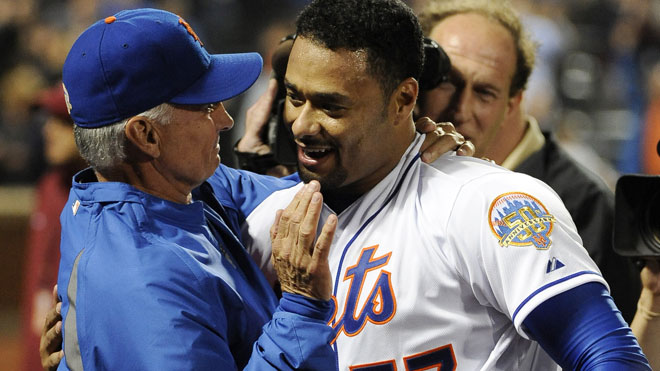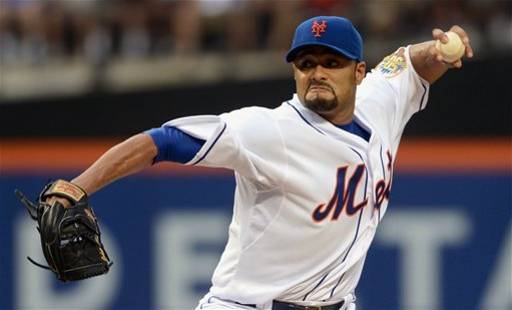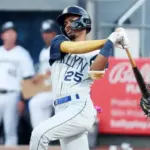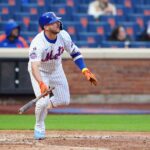The season ended about three weeks ago and now that we’ve had some time to reflect, it’s time to start handing out grades. This morning, we’ll begin with the starting pitching.
The starting pitching exceeded expectations this year. I don’t think anyone thought that Jon Niese or R.A. Dickey would be as dominant as they were this year. We were also very unsure about how Chris Young and Johan Santana would hold up. Both contributed more than we expected, even though Santana missed the last part of the year.
The rotation was in the top third in baseball in most categories, as you can see below:
If you look at BABIP and other stats not in this chart such as HR/FB%, luck (if you believe in it) doesn’t seem to have played a major part in the success this season. The numbers suggest that maybe the Mets got a little lucky with a few fly balls on the warning track, but it didn’t have a huge impact. This staff was good, no doubt about it.
Now let’s begin the grading…
R.A. Dickey: A+
Dickey really came out of nowhere this year. Sure, he had been very consistent in 2010 and 2011 with the Mets, but never dominated like he did this year. In June, Dickey put together one of the greatest string of starts ever seen from any pitcher, let alone a knucleball pitcher. From his last start in May through his first four June starts (5/27-6/18) Dickey did not allow a single earned run. In those five starts, a span of 41.2 innings, Dickey struck out an unbelievable 52 batters while walking only five. Did I mention the streak also included two consecutive one-hit shutouts? (Dickey became the first pitcher to do that since Dave Stieb in 1988).
Dickey’s successes on the field also brought national attention to his personal life. The grade I gave to Dickey was completely based on his pitching performance this season, but he handled him self with so much class off the field this season, bringing attention to an important issue. If I was grading professionalism, I’d give Dickey an A+ once again.
Dickey had one of the best seasons a knuckleball pitcher has ever had. He had quite a few factors working against him: sub-par defense, the knuckleball itself, and the torn abdominal muscle that he fought through from April on. Hopefully, this year will culminate in Dickey receiving the Cy Young Award next month.
Jonathon Niese: B+
With the security of a new five-year deal he signed in March, Niese finally got comfortable in his role with the Mets. He finally broke out after a few up-and-down, injury-riddled seasons, and became the consistent pitcher he was supposed to become. Another big positive was his durability. He had not been able to complete a full season until this year, making 30 starts and throwing a career-high 190.1 innings. He not only stayed healthy in the second half, but he also got better as the season went on.
It felt like every night Niese was going seven innings and allowing one or two runs this season. His future looks very bright.
Johan Santana: B-

The first half for Santana was very promising. Of course, the no-hitter was the high point, but he pitched very well the entire first half with only one or two exceptions. Before the All-Star break, he had a 3.24 ERA in 102.2 innings and was striking out 8.7 batters per nine. The struggles really began in his last start before the break against the Cubs, when Reed Johnson stepped on his ankle. From that game on, he gave up 33 runs in 19 innings (15.63 ERA) and could not find the strike zone. Fatigue was clearly getting to him, and he was eventually shut down.
Looking back, it probably wasn’t fair to expect Santana to stay healthy for an entire season. So despite the fact that he had to be shut down early, this year was a good sign that Santana still has something left. Hopefully, after throwing 117 innings this year, he will be able to build off that and pitch a full season in 2013.
Matt Harvey: A-
Harvey lived up to the hype. After dominating the first two-thirds of the season in Triple-A Buffalo, Harvey was called up in a very controversial move by the Mets front office. Many believed the Mets should be patient and give him only a few September starts while others were pleading for him in hopes that he could save the quickly-fading Mets season.
He made his debut in Arizona, where he struck out eleven in just 5.1 innings. After two up-and-down starts, Harvey really got into a groove over his last seven starts, which you can see below:
Matt has never really been touted as a future dominant, number one guy. “Experts” often say his ceiling is a very good second starter. I’m convinced that he has the “stuff” as well as the composure to be an ace. He has a great fastball, which averaged about 95.4 miles per hour this season, as well as a devastating curveball. His whiff rate on his curve was 42.42%, tenth in baseball (min. 50 curveballs thrown).
Harvey will break camp with the team next year, pitching his first full season in the big leagues. It should be a very exciting year for him.
Chris Young: C+
Young gave the team about as much as you could want from an older starting pitcher who hadn’t pitched a full season in five years. After having the same procedure as Johan Santana, Young signed in late-March and joined the team on June 5. Young doesn’t have much left, but made the most of hit. Despite the occasional game that made you shake your head, he was very solid. He was clearly limited this season with how far he could go into games, and Terry Collins never tried to push it with him.Being a frequently-hurt pitcher like Young is such an uphill battle. You can’t push it because your arm doesn’t have the strength, but in order to be able to build up to the point where you can pitch a full season, you need to pitch. Young averaged 92.35 pitches in 20 starts this year, which, like Santana, will hopefully get his pitching career moving again next year, whether he’s with the Mets or not.
Dillon Gee: B
Gee was very consistent as well this year. Before the scary blood clot incident that cost him the last ten weeks of the season, Gee looked like he was building off a surprising 2011 campaign. He doesn’t have any great breaking pitches or an amazing fastball, but he uses his biggest strength- his changeup – to his advantage.
Gee made big strides with his improvement this year, going from 4.0 walks per nine innings in 2011 to a 2.4 mark this year. He also raised his K/BB ratio from 1.61 to 3.34. He definitely has the makings of an above-average starter, something most teams can’t say about their fourth starter.
Jeremy Hefner: C
Claimed off waivers twice in the past year, Hefner was probably one of the more underrated acquisitions of the off-season. The Mets got him twice for practically nothing. At times, it sure didn’t look pretty for Hefner on the mound but for the most part, he did his job. He ate innings and was a good longman out of the bullpen.
Overall: B
This rotation has a bright future ahead. With Gee, Niese, and Harvey, it’s young. Plus, Dickey could pitch like this for five more years, we really have no idea. What will make this rotation even more impressive is Zack Wheeler, who will make his debut at some point net season. If he turns out to be the ace he’s supposed to become, or even if he’s just a number three starter-type, the Mets have a very good starting pitching core going forward. It’s definitely the area of the team I’m most excited about and will be what carries the Mets to the postseason in the coming years.



















